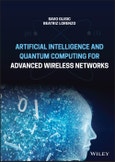A comprehensive presentation of the implementation of artificial intelligence and quantum computing technology in large-scale communication networks
Increasingly dense and flexible wireless networks require the use of artificial intelligence (AI) for planning network deployment, optimization, and dynamic control. Machine learning algorithms are now often used to predict traffic and network state in order to reserve resources for smooth communication with high reliability and low latency.
In Artificial Intelligence and Quantum Computing for Advanced Wireless Networks, the authors deliver a practical and timely review of AI-based learning algorithms, with several case studies in both Python and R. The book discusses the game-theory-based learning algorithms used in decision making, along with various specific applications in wireless networks, like channel, network state, and traffic prediction. Additional chapters include Fundamentals of ML, Artificial Neural Networks (NN), Explainable and Graph NN, Learning Equilibria and Games, AI Algorithms in Networks, Fundamentals of Quantum Communications, Quantum Channel, Information Theory and Error Correction, Quantum Optimization Theory, and Quantum Internet, to name a few.
The authors offer readers an intuitive and accessible path from basic topics on machine learning through advanced concepts and techniques in quantum networks. Readers will benefit from:
- A thorough introduction to the fundamentals of machine learning algorithms, including linear and logistic regression, decision trees, random forests, bagging, boosting, and support vector machines
- An exploration of artificial neural networks, including multilayer neural networks, training and backpropagation, FIR architecture spatial-temporal representations, quantum ML, quantum information theory, fundamentals of quantum internet, and more
- Discussions of explainable neural networks and XAI
- Examinations of graph neural networks, including learning algorithms and linear and nonlinear GNNs in both classical and quantum computing technology
Perfect for network engineers, researchers, and graduate and masters students in computer science and electrical engineering, Artificial Intelligence and Quantum Computing for Advanced Wireless Networks is also an indispensable resource for IT support staff, along with policymakers and regulators who work in technology.
Table of Contents
Preface, xiii
Part I Artificial Intelligence, 1
1 Introduction, 3
1.1 Motivation, 3
1.2 Book Structure, 5
2 Machine Learning Algorithms, 17
2.1 Fundamentals, 17
2.2 ML Algorithm Analysis, 37
3 Artificial Neural Networks, 55
3.1 Multi-layer Feedforward Neural Networks, 55
3.2 FIR Architecture, 60
3.3 Time Series Prediction, 68
3.4 Recurrent Neural Networks, 69
3.5 Cellular Neural Networks (CeNN), 81
3.6 Convolutional Neural Network (CoNN), 84
4 Explainable Neural Networks, 97
4.1 Explainability Methods, 99
4.2 Relevance Propagation in ANN, 103
4.3 Rule Extraction from LSTM Networks, 110
4.4 Accuracy and Interpretability, 112
5 Graph Neural Networks, 135
5.1 Concept of Graph Neural Network (GNN), 135
5.2 Categorization and Modeling of GNN, 144
5.3 Complexity of NN, 156
6 Learning Equilibria and Games, 179
6.1 Learning in Games, 179
6.2 Online Learning of Nash Equilibria in Congestion Games, 196
6.3 Minority Games, 202
6.4 Nash Q-Learning, 204
6.5 Routing Games, 211
6.6 Routing with Edge Priorities, 220
7 AI Algorithms in Networks, 227
7.1 Review of AI-Based Algorithms in Networks, 227
7.2 ML for Caching in Small Cell Networks, 237
7.3 Q-Learning-Based Joint Channel and Power Level Selection in Heterogeneous Cellular Networks, 243
7.4 ML for Self-Organizing Cellular Networks, 252
7.5 RL-Based Caching, 267
7.6 Big Data Analytics in Wireless Networks, 274
7.7 Graph Neural Networks, 279
7.8 DRL for Multioperator Network Slicing, 291
7.9 Deep Q-Learning for Latency-Limited Network Virtualization, 302
7.10 Multi-Armed Bandit Estimator (MBE), 317
7.11 Network Representation Learning, 327
Part II Quantum Computing, 361
8 Fundamentals of Quantum Communications, 363
8.1 Introduction, 363
8.2 Quantum Gates and Quantum Computing, 372
8.3 Quantum Fourier Transform (QFT), 386
9 Quantum Channel Information Theory, 397
9.1 Communication Over a Channel, 398
9.2 Quantum Information Theory, 401
9.3 Channel Description, 407
9.4 Channel Classical Capacities, 414
9.5 Channel Quantum Capacity, 431
9.6 Quantum Channel Examples, 437
10 Quantum Error Correction, 451
10.1 Stabilizer Codes, 458
10.2 Surface Code, 465
10.3 Fault-Tolerant Gates, 471
10.4 Theoretical Framework, 474
11 Quantum Search Algorithms, 499
11.1 Quantum Search Algorithms, 499
11.2 Physics of Quantum Algorithms, 510
12 Quantum Machine Learning, 543
12.1 QML Algorithms, 543
12.2 QNN Preliminaries, 547
12.3 Quantum Classifiers with ML: Near-Term Solutions, 550
12.4 Gradients of Parameterized Quantum Gates, 560
12.5 Classification with QNNs, 568
12.6 Quantum Decision Tree Classifier, 575
13 QC Optimization, 593
13.1 Hybrid Quantum-Classical Optimization Algorithms, 593
13.2 Convex Optimization in Quantum Information Theory, 601
13.3 Quantum Algorithms for Combinatorial Optimization Problems, 609
13.4 QC for Linear Systems of Equations, 614
13.5 Quantum Circuit, 625
13.6 Quantum Algorithm for Systems of Nonlinear Differential Equations, 628
14 Quantum Decision Theory, 637
14.1 Potential Enablers for Qc, 637
14.2 Quantum Game Theory (QGT), 641
14.3 Quantum Decision Theory (QDT), 665
14.4 Predictions in QDT, 676
15 Quantum Computing in Wireless Networks, 693
15.1 Quantum Satellite Networks, 693
15.2 QC Routing for Social Overlay Networks, 706
15.3 QKD Networks, 713
16 Quantum Network on Graph, 733
16.1 Optimal Routing in Quantum Networks, 733
16.2 Quantum Network on Symmetric Graph, 744
16.3 QWs, 747
16.4 Multidimensional QWs, 753
17 Quantum Internet, 773
17.1 System Model, 775
17.2 Quantum Network Protocol Stack, 789
References, 814
Index, 821








